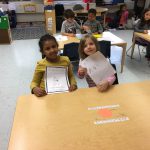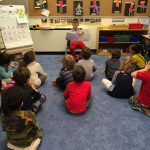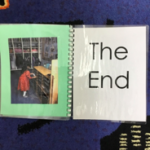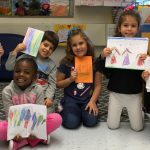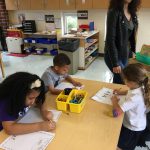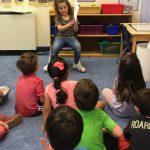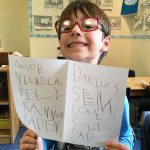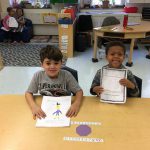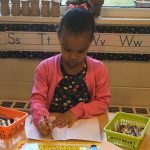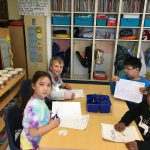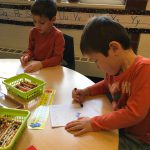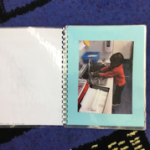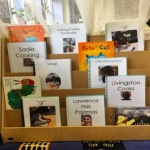Submitted by the Early Childhood Faculty
In our kindergarten, it is routine for teachers to pull up a chair alongside children to confer about a piece of their writing. Two years earlier, those same children may have pulled up a chair alongside a teacher who is writing and tried to imitate them. With clipboard, paper, and crayon in hand, preschool children mimic the posture, arm and hand movements of their teachers, especially when teachers are taking notes on their peers, perfectly capturing purposeful writing. When the dramatic play area becomes a doctor’s office, the children scribble “prescriptions” on pads, another imitation of purposeful writing.
One of the ultimate accomplishments of our emergent writers and readers is to create books. Bookmaking happens throughout our early childhood program. “Oral rehearsal” — repeatedly speaking words that may then become part of a book’s text — is an integral part in the process.
Preschool 3: Marisa Tepley, Rachel DiGiovanni, and Mary Cushman
A precursor to writing is telling a sequential story. In Preschool 3, the most popular subject in storytelling is self. Many three- and four-year-olds enjoy speaking about their experiences. In Preschool 3, we create books about each student by photographing jobs and routines that have a true beginning, middle, and end. The students take “picture walks” through the photographs to develop their titles. Once the books are laminated and bound, the preschoolers -with support from their teachers – read their books to the class. They use transitional words such as first, next, and then. Their books become part of the classroom library until their next publication is ready. Our budding authors are now on their third books, which contain printed text that they have dictated.
Preschool 3 children enjoy drawing. By spring, some are drawing several pictures at a time, and often they reveal to the teachers what they are thinking about or representing on the pages. We jot down their words and ask if they’d like to staple the pages together and make a book. These books may be read aloud to the class by a teacher before being sent home. As you will read below, by Preschool 4 this kind of bookmaking becomes more structured, focused, and independent.
Preschool 4: Teresa Cali and Ericka Butler
In Preschool 4, it is an exciting experience for the children to take their bookmaking to the next level. They understand what an author and illustrator are and appreciate what goes into the making of a book. They learn about different styles of writing and drawing through our many author studies. Children gravitate to the writing center where they create their own original books, incorporating their own pictures and/or words. Before a child begins making a book, a topic may be discussed at a meeting with the whole class or in a one-on-one meeting with a teacher. The Writing Center in the classroom is open for the children to go to at any point in the day should they get a book idea on their own.
The Writing Center has all the materials children need for bookmaking, including pre-stapled blank books, a variety of colored pencils and crayons, letter stamps and pads, whiteboards, chalkboards, sandpaper letters and an alphabet chart. At this age, some children choose to dictate their words, while others begin labeling their pictures using sound spelling. Some writers verbally narrate their picture stories without putting words on a page. When their books are complete, the children have an opportunity to share their books with the class while they sit in a designated author and illustrator chair. It is a delightful and gratifying experience for children to share their books with their friends.
Kindergarten: Tricia Fiore, Lorraine Yamin, Sandy De Cos, and Kristina Gomez
On the first day of kindergarten, teachers gather students in a huddle near the easel to share the great news that bookmaking is celebrated every day and that every student in the room is an author. Students are introduced to Writer’s Workshop, the time in their schedule when they first receive a ten-minute “mini-lesson” where teachers share information about what writers do. This mini lesson is followed by 20 to 30 minutes of practice bookmaking and being an author.
The Writer’s Workshop approach capitalizes on kindergartners’ desire to show the world everything they know. The mechanics of the workshop eventually include planning a book with illustrations, adding labels and word approximations, stretching out words orally to hear the sounds and get them on the page, and using a letter board to help remember sound/letter correspondences. Children learn to share their drafts with a partner and revise. There are three big units of study: narrative writing, “how-to” pieces, and opinion pieces, each culminating in a celebration of everyone’s best work with a publishing party.

